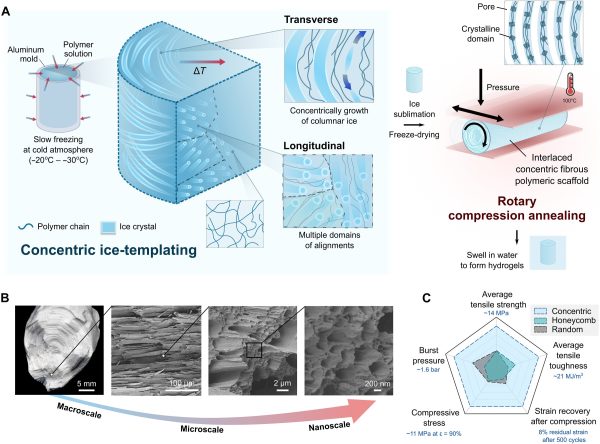News Express: UM achieves breakthroughs in bioinspired hydrogel technology
新聞快訊:澳大團隊在仿生水凝膠研究取得突破性進展

“同心冰模板法”製備具有仿生環向結構水凝膠示意圖及與其它水凝膠的性能對比
Schematic illustration of how the concentric ice-templating technique constructs hydrogels with bioinspired circumferentially aligned fibrous structures, and a comparison of their performance with other hydrogels
澳大團隊在仿生水凝膠研究取得突破性進展
澳門大學科技學院機電工程系助理教授李奕雯及其研究團隊首次利用“同心冰模板法”,成功製備出具有仿生環向纖維結構的水凝膠,解決了傳統技術僅能生成蜂窩或層狀結構的局限性,使材料在抗壓性、韌性及抗疲勞性方面表現顯著提升,拓展了冰模板法的應用範疇及人工水凝膠的力學性能。相關研究成果已發表於國際知名綜合性學術期刊《科學進展》(Science Advances)。
自然界中,如椎間盤、血管、魚鰾等生物組織因具有環向纖維狀結構而具備優越的力學性能。傳統冰模板法通過控制冰的定向生長來製造仿生結構的水凝膠,只能製造有限結構,且成本高昂、效率低下,嚴重限制了仿生水凝膠在性能上與自然材料的匹配。研究團隊發現,通過慢速冷凍能誘導冰晶平行於冷源生長,據此研發出“同心冰模板法”,首次成功構建新的環向纖維結構。此外,團隊亦改良現有退火工藝,開發出旋轉壓縮退火方法,令水凝膠在保持85 wt.%含水量的情況下,具備高強度、高韌性、抗疲勞性能、可壓縮性、高爆破壓等多重機械性能,使材料微觀結構更加緻密,進一步提升結晶度。
新型仿生水凝膠具備廣泛應用潛力,特別適用於軟體機器人和生物再生工程領域,如製作具高驅動力的水凝膠氣動驅動器、軟體抓手、仿生機器魚和水下作業的偽裝軟體機器人。
該研究通訊作者為李奕雯,第一作者為澳大科技學院博士生谷文熙。該研究由澳門特別行政區科學技術發展基金(檔案編號:0119/2022/A3、0009/2023/ITP1、0113/2024/RIB2)、澳門大學及澳門大學發展基金會(檔案編號:SRG2022-00038-FST、MYRG-GRG2023-00225-FST-UMDF)資助。全文可瀏覽:https://www.science.org/doi/10.1126/sciadv.adv7786。
欲瀏覽官網版可登入以下連結:
https://www.um.edu.mo/zh-hant/news-and-press-releases/press-release/detail/61614/
UM achieves breakthroughs in bioinspired hydrogel technology
A research team led by Lei Iek Man, assistant professor in the Department of Electromechanical Engineering of the Faculty of Science and Technology (FST) at the University of Macau (UM), has developed a novel concentric ice-templating technique that constructs hydrogels with bioinspired circumferentially aligned fibrous structures. This breakthrough overcomes the limitations of traditional ice-templating methods, which can only produce simple structures such as honeycomb or lamellar structures. The new approach significantly improves the mechanical properties of hydrogels in terms of compression, toughness, and fatigue resistance, thereby expanding the scope of application of the ice-templating method and improving the mechanical properties of artificial hydrogels. The findings have been published in Science Advances, an internationally renowned multidisciplinary journal.
Natural materials with circumferential fibrous structures, such as intervertebral discs, arteries, and fish swim bladders, possess remarkable mechanical properties. Although traditional ice-templating can create bioinspired structures through controlling directional ice growth, the range of achievable structures remains severely limited and these techniques are often costly and inefficient, making it difficult to replicate the mechanical performance derived from the structures of natural materials. The research team discovered that slow freezing could induce ice crystals to grow parallel to the cooling source. Based on this insight, they, for the first time, developed ‘concentric ice-templating’ to construct circumferential fibrous structures in hydrogels. Additionally, the team improved existing annealing techniques by introducing a ‘rotary compression annealing’ strategy to densify the microstructure and increase its crystallinity. With these approaches, the resulting hydrogel retains a high water content (85 wt.%) while achieving multiple mechanical advantages, including high strength, toughness, fatigue resistance, compressibility, and burst pressure.
This innovative bionic hydrogel holds broad application potential, particularly in soft robotics and tissue engineering. It can be used to develop hydrogel pneumatic actuators with high actuation force, soft grippers for handling delicate objects, bionic robotic fish, and underwater camouflage soft robots.
Prof Lei is the corresponding author of the study, and Gu Wenxi, a doctoral student in FST, is the first author. The research project was supported by the Science and Technology Development Fund of the Macao SAR (File No.: 0119/2022/A3, 0009/2023/ITP1, 0113/2024/RIB2), UM, and the University of Macau Development Foundation (File No.: SRG2022-00038-FST, MYRG-GRG2023-00225-FST-UMDF). The full version of the research article is available at: https://www.science.org/doi/10.1126/sciadv.adv7786.
To read the news on UM’s official website, please visit the following link:
https://www.um.edu.mo/news-and-press-releases/press-release/detail/61614/